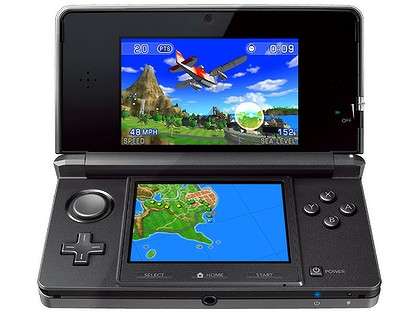The release of a new-generation game machine from one of the top video game companies happens so rarely these days that it's a momentous event.
Adding to the moment this time around is that the new gadget - the 3DS - is one of the first handheld devices to offer stereoscopic 3-D gaming and is coming from Nintendo, a company that has dominated the handheld gaming market for more than 20 years.
Unfortunately, the 3-D effect that gives the 3DS its name often feels like a pricey, headache-inducing gimmick. And the 3-D technology aside, the 3DS feels in several respects like a relic from an earlier era of gaming.
The 3DS is one of the first mainstream examples of an autostereoscopic device, which means it's able to produce a 3-D image by itself, without requiring the use of special headgear or goofy glasses. To achieve its 3-D effect, the 3DS uses a technology called a parallax barrier, which is basically a screen that sits in front of the main display. The barrier works like an overlapping pair of Venetian blinds, directing a separate image to each of a user's two eyes. The user's brain stitches together the two sets of images to create the optical illusion of three dimensions.
The 3DS will play most games made for the various iterations of the Nintendo DS, the device it succeeds. But to get the 3-D effect, 3DS owners will have to play games specifically designed for the new gadget.
That's not a huge issue because game makers had expected about 18 3-D games to be available for the 3DS as soon as it hit store shelves Sunday. Nintendo representatives say about 12 more games will reach the market between now and early June.
Additionally, Nintendo has built into the device a handful of apps that take advantage of its 3-D capabilities, including two mini-games, and a pair of rear-facing cameras with which users can take 3-D pictures that they can view on the 3DS's screen.
In the future, 3DS owners could also be able to use the gadget to watch 3-D movies, trailers and TV shows.
Let me confirm that the 3DS autostereoscopic 3-D technology does, in fact, work, and in some cases was a lot of fun. It was neat to view a picture of my daughter in 3-D, for example. And the 3-D effect enhanced Electronic Arts' "Madden NFL Football," allowing me to get a real sense of the field of play.
But because of the limitations of its 3-D technology, the 3DS can be trying and wearisome, which is not the way you want to describe a game system.
The 3-D works well if you hold the device still and at a fixed distance from your face. I don't know about you, but that's pretty much impossible for me to do while playing games on a handheld device.
If I'm driving a virtual race car, my natural inclination is to tilt the screen left or right or back and forth as I zoom along the track. Recent game-playing devices, such as Apple's iPod touch, have embraced such tics by incorporating motion-sensing technology.
Although the 3DS has similar motion detectors, if you move it around too much, you negate the 3-D effect. Instead of seeing a deep 3-D image, you see a much dimmer image or two overlapping ones. Either way, the experience is disorienting and eye-straining.
Nintendo warns that kids under 7 shouldn't play games with the 3-D effect turned on because it might affect their vision. There's been some debate about whether these fears are overblown, but as the father of two young kids, the warning was enough to give me pause - and to turn off the 3-D effect whenever I let them play on the 3DS.
Such concerns could be a big problem for Nintendo. Kids have long comprised a large part of the core audience for its handheld game machines, and turning off the 3-D effect eliminates the reason for having the 3DS. Once you turn off the 3-D effect, the device is little more than a much more expensive Nintendo DS.
The 3DS has other shortcomings. Many of the latest games for handheld devices have been designed for those with touch screens with which users interact using their fingers. But as with the DS line, only one of the 3DS's screens is touch-sensitive, and that screen is designed to be used with a stylus - not your finger. Unfortunately, once you get used to a touch screen, you don't want to go back to using a stylus or buttons.
Also disappointing is the lineup of initial 3DS games. Of the seven I tested, few offered a compelling 3-D experience. In many cases, the 3-D simply felt like a gimmick used to dress up flat 2-D games.
So my advice is that if you're in the market for a handheld game machine, stick with Nintendo's older DS or buy an iPod touch. They're both a lot easier on the eyes and, in the case of the DS, a lot lighter on the pocketbook.
---
NINTENDO 3DS HANDHELD GAME SYSTEM
-Troy's rating: 5.5 (out of 10)
-Likes: Generate 3-D effect without requiring glasses; dual rear-facing cameras can be used to take 3-D pictures; backward compatibility with Nintendo DS.
-Dislikes: Pricey; 3-D effect has narrow viewing angle; one screen not touch-sensitive, other not designed for fingertip interaction; initial game lineup has few that make 3-D effect compelling.
-Specs: Autostereoscopic 3.5-inch main screen, 3-inch touch-sensitive lower screen
-Price: $250
-Web: nintendo.com
(c) 2011, San Jose Mercury News (San Jose, Calif.).
Distributed by McClatchy-Tribune Information Services.






















